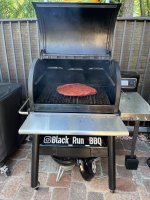@bbqking I just did another brisket yesterday and injected KosmoQ injection and liquid retention and had worse results!! ugh.... This looks like a 4-5#, i just did a 4# one and i do have to confess that i didn't pay a lot of attention to it. I started at 250F and wrapped it in pink paper at 170F with beef broth. The temp dropped and went back up, i turned it up to 300F and it didn't get over 190F internal. It was so dry....and I was at least 8 hours in... not sure what i'm doing wrong at this point...any thoughts?
First off, it’s best to do a whole packer brisket if you are new to the experience. The overall mass allows a RE much wider margin of error.
Secondly, you must but the highest grade meat you can comfortably afford.
Thirdly, I’d wrap in foil in lieu of butcher paper if you are new to this. It also allows a wider margin of error because it retains all the moisture in the foil. Yes the bark will be softer, but who cares compared to dry meat?
Fourth, I would assume you are not getting good readings from your thermometers. If you are using a stick and stay thermo of any brand, it needs to be verified in several places with a top quality instant read. I recommend a ThermoWorks Thermapen.
Fifth, it is done when it probes like butter. That is usually @200-205 degrees IT. But not always.
Sixth, a east is critical. The larger the protein the longer the rest. I generally go minimum of an hour and prefer two hours. It is important to let it sit out unwrapped for 15 minutes to let it cool slightly or the carryover cook will no too much. Then wrap back up and throw in a cooler or oven on lowest setting.
Lastly, it is important to remember that brisket is not the most moist cut to begin with. Even a expertly cooked brisket is only so moist. You must not cut the whole thing up ahead of time or it will dry out in a hurry.
Good luck with the next one. I’m a firm believer in the commercial injections, that is definitely not the issue.















